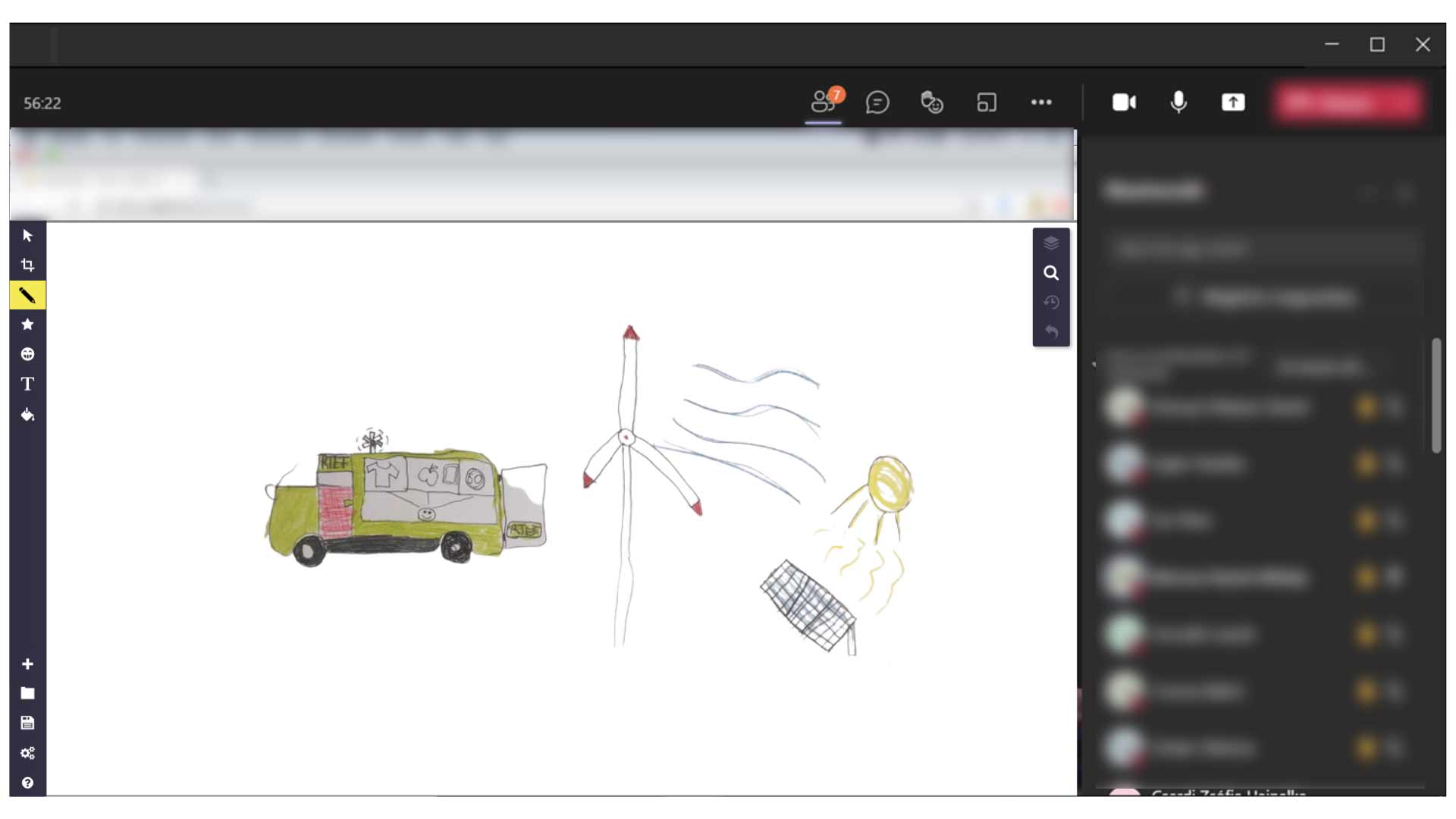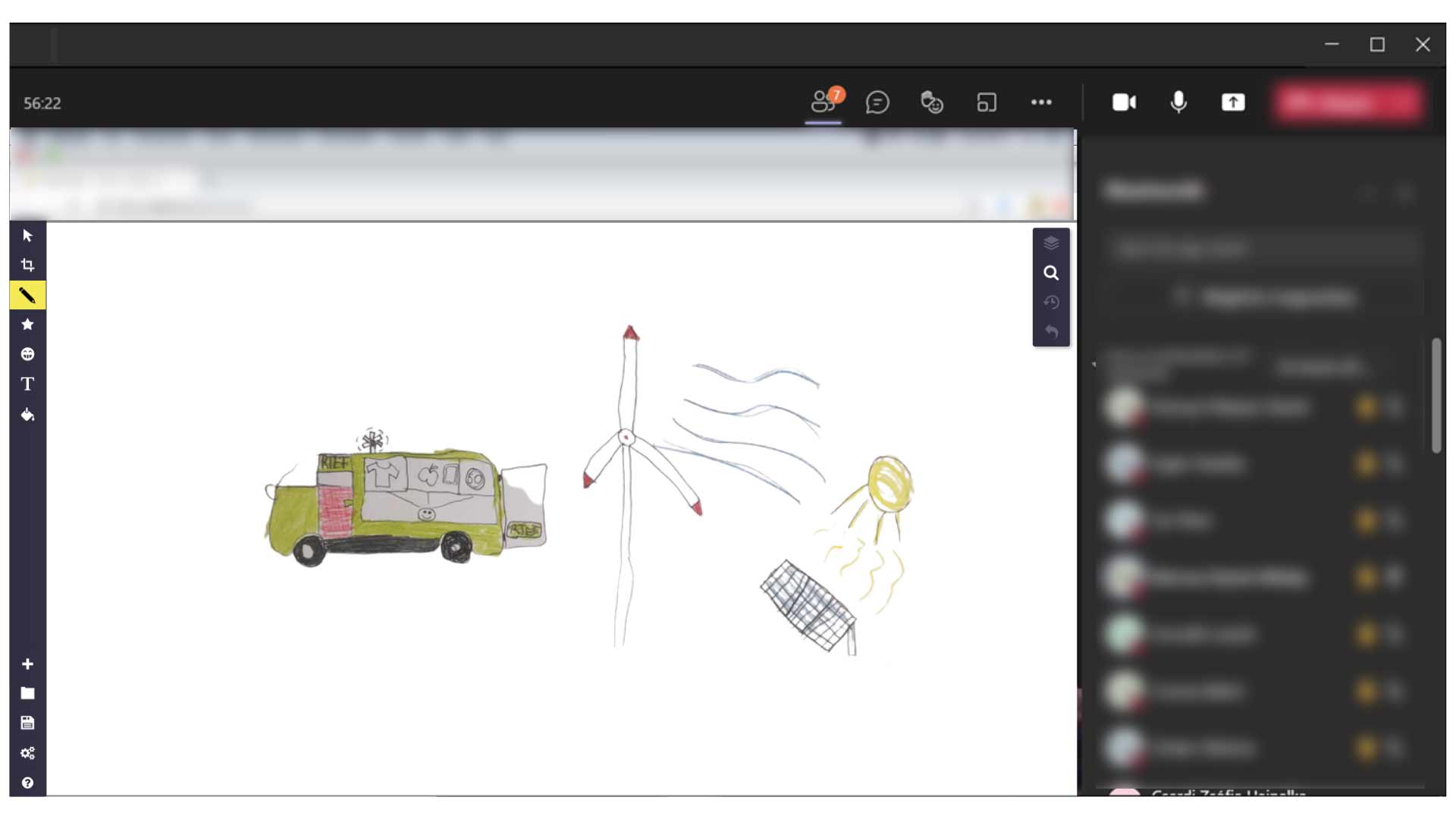
Soft skill development
Soft skill developmentby means of artistic co-creation
This task nurtures creativity and supports soft skill development through virtual co-creation, referred to as “wikinomics” cooperation. It aims for the group to realize the potential of digital teamwork. Participants use a question, assignment, or a thought-provoking message as a starting point to set the direction, while being allowed to choose their own tools, topic, and ways of expression. A sense of shared responsibility will enhance the potential of teamwork and support its development.
Description
The assignment focuses on soft skill development. It is based on the methodology of designcommunication and creative communication between artists. Critical thinking and problem-solving skills are developed in a creative process using “wikinomics” cooperation. Participants acquire various soft skills through multiple forms of art. While they are immersed in the process of co-creation, undervalued skills, which are difficult to improve in education due to lack of time, are developed unnoticeably. Creativity unfolds in the collaborative dimension.
The assignment is more of a methodological framework than a specific task; while it is mastered, the team and their mentor embark on a journey that offers continuous development, where the evolving topic its related goals, and the choice of the online platform guarantee diversity and thus a versatile result.
Tasks and specific work steps
- A1 – Preparations by the teacher: to assess the group, define the field of art used, to record the assigned project/problem/task/topic
Steps:
- A2 – Online lesson, cameras must be switched on. We assume that the team members know each other, at least in the online environment. As a first step, the teacher presents the basic notions of designcommunication and its methodology (e.g., background materials, relevant literature provided): Understanding the relationship between surviving/sustaining/prospering, permanent/evolving, material/immaterial, and discussing the ways that they can be applied in the various fields of art.
- Basic notions of designcommunication:
- surviving/sustaining/prospering: it is environmentally conscious, it is progressive as seen from the past, but also regarding the future
- permanent/evolving: the created product is ageless and lasting, despite the constantly evolving environment and trends
- material/immaterial: its underlying message has additional value beyond its material meaning
- Basic notions of designcommunication:
- A3 – The teacher presents the exercise’s initial topic aims. The topic can be customized for the people involved, the area, and the development focus. The aim, however, stays the same in every case: to create value together, on group a level, where every team member can identify with the creation method and the result.
- Recommended topics:
- Values: sustainability/CSR (Corporate Social Responsibility), inclusive approach, rethinking of a holiday, workshop focusing on a specific problem, rethinking existing processes
- For the solution, participants must use at least one (but preferably more) free digital tools, which enable collaborative creation. It is important that the students explore and find such an online platform as the starting point of their teamwork.
- Recommended topics:
- A4 – After presenting the topic, the students are given 5–10 minutes to prepare individually, during which they make notes and mind maps. The teacher explains the task by providing a specific topic, but this topic can be modified. For example: “Design a sustainable classroom for a primary school by using tools from art.”
- A5 – The teacher divides the students randomly into groups of 3–5 by opening online rooms for them. They are given approximately 30 minutes to come up with a solution together. Using a specific example as an illustration, they start discussing what, e.g., sustainability means (overview of the concept, desk research) and what artistic tools they have/may have for the design process. They have to analyze the criteria for feasibility (human resources, budget, etc.). After this, they start discussing the specifics. Which online tools are available, and how to create the online product (e.g., a joint draft, a manifesto, a video on the concept, etc.). The design process does not have to produce a specific object; an action plan in itself is accepted as a result.
- A6 – The students “return” to the shared space, and the work starts: wikinomics cooperation, that is, group-level value creation, creating the product. The groups share their opinions in the common wikinomics space; then, they have to reach a consensus on a solution that is acceptable for everyone, followed by an action plan for implementation. Tasks are assigned, and the social platform is selected.
- A7 – Creating and presenting the product, the work of art that reflects on the problem and the initial information. The allocated time can vary depending on the complexity of the solution. It is recommended to allow an extra 30 minutes so that the students can make the most of the flow experience of the creative process.
- A8 – At the end, extra time must be given to discuss the experiences/creative moments of the process, starting with free association and followed by direct questions. Participants are prompted to give a self-reflexive report.
- Examples for questions:
- How did you feel during the process?
- Give three examples that helped your creative process and another three that hindered it.
- How would you define your OWN role in the team’s work?
- Did any roles emerge within the team, and if yes, what were they?
- If you could start again with the creative process, what would you do differently?
- Examples for questions:
- The teacher’s active presence is essential during the exercise, but the teacher must neither take on a leading role nor give specific instructions. The teacher only “ensures” that the students keep to the time limit. They must not interfere with the work or help assign roles within the groups. They may recommend online co-editing platforms, but only at the start of the exercise. They must not channel thoughts, influence, or help students overcome deadlocks. The teacher needs to understand that in this project, the actual result is the creative process itself and not the designed product.
Sources and References
- Galla, Daniella Dominika (2021) Children. Home. Cooperation. Creativity. A designcommunication as an educational methodological tool to support the development of soft skills. (PhD thesis, Corvinus University of Budapest, Doctoral School of Business and Management. DOI 10.14267/phd.2021041,
http://phd.lib.uni-corvinus.hu/1156/19/galla_daniella_den.pdf - Horváth, D., Cosovan, A., Csordás, T., Horváth, D., & Mitev, A. Z. (2018). Marketing as Designing: Design Methods in Marketing Education–Introduction to DesignCommunication.
- Horváth, D. D., Csordás, T., Horváth, D., & Cosovan, A. (2020). Úgy, mint a nagyok! Kreatív workshop általános iskolásoknak. (Just like the big ones! Creative workshop for primary school pupils). Iskolakultúra (School Culture), 30(4-5), 49–66. Source:
https://ojs.bibl.u-szeged.hu/index.php/iskolakultura/article/view/33133
Images/Examples

Students are working together online @ 2021 by Daniella Dominika Galla is licensed under CC BY-SA 4.0
Additional Information
Author’s Encouragement
The students “unnoticeably” acquire skills that are difficult to gain consciously. They shape the creative process themselves. There are no pre-assigned and strictly defined team roles and reporting milestones. This initial uncertainty may result in deadlocks, but the ultimate aim is solution-focused teamwork. The online environment may benefit students who are less self-assured in the offline space. Co-creation of the final product establishes a strong connection even between physically isolated students, strengthens group cohesion, and enhances performance during other online and offline individual and community project work.
Prior Knowledge and Preparation
Teachers are advised to study the methodology, that is, the theoretical background of designcommunication (see listed literature). For the students, familiarity with smart devices and online platforms for co-editing is an advantage.
It is recommended to include the task of mapping these as a subject of the first workshop, rather than scheduling it separately as an introduction, since this evens out the various levels in the students’ relevant knowledge and skills.
Accessibility:
Assistance for Learners
The topic determines the level and type of preliminary knowledge. If the teacher knows the group well, selecting the starting “problem” in itself can be a supportive starting point. It also allows for resolving the problem of different knowledge and skill levels, since the topic is adjusted to the group’s previous and known knowledge base. This is the teacher’s task and responsibility.
Additional Tools
- Microsoft Teams
(or other virtual environment) - Google Jamboard
(or another co-editing platform)